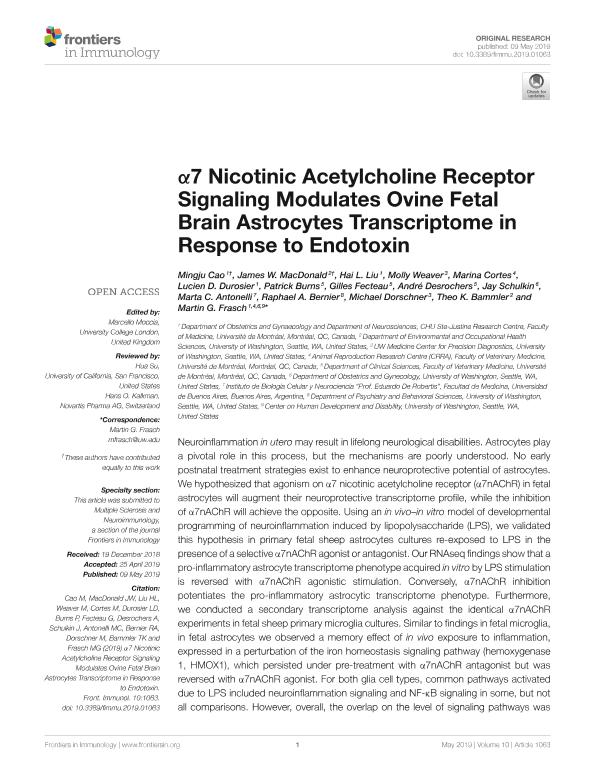Mostrar el registro sencillo del ítem
dc.contributor.author
Cao, Mingju
dc.contributor.author
MacDonald, James W.
dc.contributor.author
Liu, Hai L.
dc.contributor.author
Weaver, Molly
dc.contributor.author
Cortés Miguez, Marina

dc.contributor.author
Durosier, Lucien D.
dc.contributor.author
Burns, Patrick
dc.contributor.author
Fecteau, Gilles
dc.contributor.author
Desrochers, André
dc.contributor.author
Schulkin, Jay
dc.contributor.author
Antonelli, Marta Cristina

dc.contributor.author
Bernier, Raphael A.
dc.contributor.author
Dorschner, Michael
dc.contributor.author
Bammler, Theo K.
dc.contributor.author
Frasch, Martin Gerbert

dc.date.available
2021-07-15T13:46:45Z
dc.date.issued
2019-05
dc.identifier.citation
Cao, Mingju; MacDonald, James W.; Liu, Hai L.; Weaver, Molly; Cortés Miguez, Marina; et al.; Α7 nicotinic acetylcholine receptor signaling modulates ovine fetal brain astrocytes transcriptome in response to endotoxin; Frontiers Media S.A.; Frontiers in Immunology; 10; MAY; 5-2019; 1-13
dc.identifier.issn
1664-3224
dc.identifier.uri
http://hdl.handle.net/11336/136194
dc.description.abstract
Neuroinflammation in utero may result in lifelong neurological disabilities. Astrocytes play a pivotal role in this process, but the mechanisms are poorly understood. No early postnatal treatment strategies exist to enhance neuroprotective potential of astrocytes. We hypothesized that agonism on α7 nicotinic acetylcholine receptor (α7nAChR) in fetal astrocytes will augment their neuroprotective transcriptome profile, while the inhibition of α7nAChR will achieve the opposite. Using an in vivo-in vitro model of developmental programming of neuroinflammation induced by lipopolysaccharide (LPS), we validated this hypothesis in primary fetal sheep astrocytes cultures re-exposed to LPS in the presence of a selective α7nAChR agonist or antagonist. Our RNAseq findings show that a proinflammatory astrocyte transcriptome phenotype acquired in vitro by LPS stimulation is reversed with α7nAChR agonistic stimulation. Conversely, α7nAChR inhibition potentiates the pro-inflammatory astrocytic transcriptome phenotype. Furthermore, we conducted a secondary transcriptome analysis against the identical α7nAChR experiments in fetal sheep primary microglia cultures. Similar to findings in fetal microglia, in fetal astrocytes we observed a memory effect of in vivo exposure to inflammation, expressed in a perturbation of the iron homeostasis signaling pathway (hemoxygenase 1, HMOX1), which persisted under pre-treatment with α7nAChR antagonist but was reversed with α7nAChR agonist. For both glia cell types, common pathways activated due to LPS included neuroinflammation signaling and NF-κB signaling in some, but not all comparisons. However, overall, the overlap on the level of signaling pathways was rather minimal. Astrocytes, not microglia-the primary immune cells of the brain, were characterized by unique inhibition patterns of STAT3 pathway due to agonistic stimulation of α7nAChR prior to LPS exposure. Lastly, we discuss the implications of our findings for fetal and postnatal brain development.
dc.format
application/pdf
dc.language.iso
eng
dc.publisher
Frontiers Media S.A.

dc.rights
info:eu-repo/semantics/openAccess
dc.rights.uri
https://creativecommons.org/licenses/by-nc-sa/2.5/ar/
dc.subject
ASTROCYTE
dc.subject
CHRNA7
dc.subject
FETAL PROGRAMMING
dc.subject
INFECTION
dc.subject
LPS
dc.subject
MICROGLIA
dc.subject
NEUROINFLAMMATION
dc.subject
RNASEQ
dc.subject.classification
Neurociencias

dc.subject.classification
Medicina Básica

dc.subject.classification
CIENCIAS MÉDICAS Y DE LA SALUD

dc.title
Α7 nicotinic acetylcholine receptor signaling modulates ovine fetal brain astrocytes transcriptome in response to endotoxin
dc.type
info:eu-repo/semantics/article
dc.type
info:ar-repo/semantics/artículo
dc.type
info:eu-repo/semantics/publishedVersion
dc.date.updated
2020-12-09T20:16:18Z
dc.identifier.eissn
1664-3224
dc.journal.volume
10
dc.journal.number
MAY
dc.journal.pagination
1-13
dc.journal.pais
Estados Unidos

dc.description.fil
Fil: Cao, Mingju. University of Montreal; Canadá
dc.description.fil
Fil: MacDonald, James W.. University of Washington; Estados Unidos
dc.description.fil
Fil: Liu, Hai L.. University of Montreal; Canadá
dc.description.fil
Fil: Weaver, Molly. University of Washington; Estados Unidos
dc.description.fil
Fil: Cortés Miguez, Marina. University of Montreal; Canadá
dc.description.fil
Fil: Durosier, Lucien D.. University of Montreal; Canadá
dc.description.fil
Fil: Burns, Patrick. University of Montreal; Canadá
dc.description.fil
Fil: Fecteau, Gilles. University of Montreal; Canadá
dc.description.fil
Fil: Desrochers, André. University of Montreal; Canadá
dc.description.fil
Fil: Schulkin, Jay. University of Washington; Estados Unidos
dc.description.fil
Fil: Antonelli, Marta Cristina. Consejo Nacional de Investigaciones Científicas y Técnicas. Oficina de Coordinación Administrativa Houssay. Instituto de Biología Celular y Neurociencia "Prof. Eduardo de Robertis". Universidad de Buenos Aires. Facultad de Medicina. Instituto de Biología Celular y Neurociencia; Argentina
dc.description.fil
Fil: Bernier, Raphael A.. University of Washington; Estados Unidos
dc.description.fil
Fil: Dorschner, Michael. University of Washington; Estados Unidos
dc.description.fil
Fil: Bammler, Theo K.. University of Washington; Estados Unidos
dc.description.fil
Fil: Frasch, Martin Gerbert. University of Montreal; Canadá. University of Washington; Estados Unidos
dc.journal.title
Frontiers in Immunology
dc.relation.alternativeid
info:eu-repo/semantics/altIdentifier/doi/http://dx.doi.org/10.3389/fimmu.2019.01063
dc.relation.alternativeid
info:eu-repo/semantics/altIdentifier/url/https://www.frontiersin.org/articles/10.3389/fimmu.2019.01063/full
Archivos asociados
